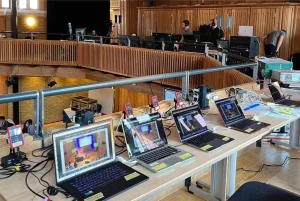China’s Population and Linguistic Diversity
Let’s start with a number: 1.4 billion. That’s how many people live in China, more than in any other country on the planet. And if you think that means everyone speaks the same way? Think again. Because the languages spoken in China represent a deep, layered, centuries-old linguistic diversity that runs from Beijing skyscrapers to remote mountain villages where no two valleys speak quite the same. In daily life, education, business, even TikTok trends, language shapes everything. Not just what people say, but how they connect, remember, and identify.
And honestly? If you’re working in or with China, assuming “Chinese” is one language is like assuming all Europeans speak Italian. It doesn’t end well.
The part population plays in linguistic variation
Big country. Big population. Even bigger mix of languages.
Mandarin dominates cities like Shanghai and Beijing. It’s the go-to for TV, schools, and government. But step outside urban centers? You’ll hear something different. Something older. Rural areas keep local tongues alive, some spoken by millions, others by only a few thousand. And thanks to migration, trade, and generations of movement, these languages don’t stay put. They blend. Evolve. Influence each other. That’s not noise. That’s history in motion. One of the richest linguistic ecosystems on Earth, and it’s powered by the sheer scale of China’s population.
Digital Growth and Language Evolution
Here’s the thing: technology isn’t flattening dialects. In some ways, it’s saving them. Social media. E-learning. Translation apps. They’re not just spreading Mandarin, they’re giving smaller languages new life online. Want to learn Hokkien slang? There’s a WeChat group for that. Trying to preserve a fading Yao dialect? Upload it to a community-driven audio archive. Schools use AI-powered tools to teach Tibetan reading skills. Canto-pop fans subtitle old comedy sketches in Cantonese even when subtitles default to Mandarin. Digital platforms aren’t replacing regional speech. They’re helping it adapt. Stay relevant. Survive. So yeah, the digital revolution isn’t erasing linguistic diversity. It’s becoming its biggest amplifier.
Mandarin Chinese: The Official and Most Spoken Language
Okay, let’s be clear: Mandarin Chinese (Putonghua) is huge. Based on the Beijing dialect, it’s the official language used in government, national media, and nearly every classroom. Around 70% of China’s population can communicate in Mandarin. That’s over 980 million people. So yes, it’s essential. For business. For law. For getting anything done across provinces. But here’s what people miss: speaking Mandarin doesn’t mean only speaking Mandarin. Think of it as the public uniform. What people wear at work. At school. On state TV. At home? With friends? During family arguments? That’s where other languages take over.
Why Mandarin Matters
It connects regions. Holds institutions together. Let someone from Harbin understand someone from Kunming without needing an interpreter. It’s also going global. More people study Mandarin than ever before second only to English as a foreign language. Companies want bilingual talent. Diplomats train in it. Universities offer full programs. But, and this is important,t its rise doesn’t erase everything beneath it. Just because someone speaks fluent Mandarin doesn’t mean their identity lives there.
How Many Languages Are We Talking?
Officially, China recognizes 56 ethnic groups. Unofficially? It’s a linguistic wild west. The sheer number of languages spoken in China is staggering, anywhere between 130 and 290+ living languages. Yes, languages. Not accents. Not dialects. Full-blown, structurally distinct systems of communication. And get this: you could speak perfect Mandarin and still have zero clue what’s being said in parts of Fujian or Guangdong… That’s not trivia. That’s reality for anyone translating content or launching a product.
Mandarin Is the National Language
No debate here. Mandarin is the backbone. Taught in schools. Required for civil service jobs. Used in courts, hospitals, and airports. Around 70 percent of the population uses it as a first or second language, and that number’s growing fast. But, and I can’t stress this enough, using Mandarin publicly doesn’t mean people abandon their mother tongues.
- Especially not in private spaces. Markets. Temples. Dinner tables.
- For millions, Mandarin is functional. Regional languages? Emotional.
- They carry humor, memory, and tradition. Things you don’t translate, you feel.
Regional Languages and Dialects in China
Mandarin may lead, but hundreds of regional languages thrive underneath. These aren’t footnotes. They’re central to local culture, music, storytelling, and identity.
Major ones include:
- Cantonese (Yue): Spoken by around 70 million, mainly in Guangdong, Hong Kong, and Macau.
- Wu (Shanghainese): Common in the Yangtze Delta, especially Shanghai.
- Min, Hakka, Xiang: Each with millions of speakers and deep cultural roots.
These dialects do more than communicate. They preserve heritage. Keep traditions alive. Resist homogenization. Without them, China wouldn’t just lose words. It would lose its soul.
Cantonese?
Let’s talk about Hong Kong. And Guangzhou. And diaspora communities worldwide. Cantonese isn’t just a language. It’s a cinema. Music. Comedy. Street food banter. Identity. Nine tones. Complex slang. A whole internet culture built on memes that only make sense if you grew up with it. And politically? Sensitive. In Hong Kong, many switch to English before switching to Mandarin. Not because they can’t. Because they don’t want to. Language isn’t neutral. It’s tied to belonging.
Also side note: translating Cantonese isn’t plug-and-play. You need someone who gets the rhythm, the attitude, the vibe. Otherwise, you’ll sound robotic. Or worse, disrespectful.
Are These Dialects or Different Languages?
China officially calls them “dialects.” But linguists? They’ll tell you otherwise.
Try this: A Shanghainese speaker talks to a Beijing native. No mutual understanding. Same with Hokkien and Mandarin. Or Hakka and Min Nan. Structurally different. Grammar. Phonology. Sometimes, even basic vocabulary. The only real link? Written Chinese characters… sort of. Even then, colloquial Cantonese writing looks nothing like formal Mandarin text. So calling them “dialects” is less about linguistics, more about politics. Unity. National narrative. But on the ground? They’re languages. Full stop.
And Then There Are the Minority Languages
Now zoom out.
Whole regions Guangxi, Inner Mongolia, Xinjiang, and Tibet, speak languages not even related to Chinese.
Examples:
- Uyghur: A Turkic language, written in Arabic script.
- Tibetan: With its own alphabet and deep Buddhist roots.
- Zhuang: Closer to Thai and Lao than to Mandarin.
- Mongolian, Korean, Kazakh, Russian: Yes, really.
Many are used in local schools, radio, and newspapers. Some have official status in autonomous regions. But let’s be honest, there’s tension. Promoting Mandarin as a unifying force sometimes comes at the cost of minority language survival. Still, efforts continue. Cultural programs. Bilingual education. Digital archives. These languages aren’t disappearing quietly.
What Do People Actually Speak at Home?
Depends on where you are.
In Chongqing: Sichuanese with neighbors, Mandarin at work, maybe English on YouTube. In Guangzhou, a Teenager understands Cantonese but types in Mandarin on WeChat. In rural Tibet, often only Tibetan is spoken. Limited Mandarin fluency. In Shanghai, Grandparents chat in Shanghainese. Grandkids barely catch it. So if you’re rolling out a campaign “in China,” ask yourself: which China? And who exactly are you talking to? One size fits none. Not even close.
Let Us Get Practical: Why This Matters
You might be thinking: “Okay, interesting. But does this affect me?” Yes. Absolutely. If you’re localizing content, doing business, running ads, or building apps for Chinese audiences, getting the language wrong can backfire hard. Google Translate won’t save you. Trust me. That’s how shampoo ends up sounding like it contains snake juice instead of coconut oil. More than “Chinese” is needed. You need cultural fluency. Someone who knows when to use simplified vs. traditional. When to go formal vs. slang. Whether your audience reads in Mandarin, writes in Cantonese, and dreams in Tibetan. Otherwise, you’re not communicating. You’re guessing.
Cultural Heritage and Language Preservation
Language = memory.
Poetry, Folktales, Religious texts. Philosophy. All carried in specific tongues. Efforts to protect minority languages Mongolian, Tibetan, and Uyghur are about more than communication. They’re about identity. Pride. Survival. Schools teach in native scripts. Festivals celebrate oral traditions. Artists sing in endangered dialects. It’s not nostalgia. It’s resistance. And it matters not just to communities, but to the world’s cultural fabric.
Religion and Linguistic Influence
Faith has shaped language in deep ways. Buddhism brought Sanskrit terms into the Chinese vocabulary. Islamic traditions influence Uyghur and Hui speech. Taoist texts shaped classical expressions. Christian translations introduced new spiritual phrases. Religion didn’t just borrow words. It transformed them. Gave them meaning. Connected people across time and belief. Even today, spiritual language carries weight. Tone. History.
Economic Apex and Global Communication
China’s economy? Massive. Influential. And Mandarin is now one of the most powerful global languages. Studied worldwide. Taught in international schools. Prioritized by diplomats and CEOs.Knowing Mandarin opens doors. But knowing which Mandarin and when to use it, that’s what builds trust.
Economic and Linguistic Impact
- Mandarin is the second most studied language globally after English.
- Global firms value employees fluent in Chinese communication.
- Language is now a key tool of China’s soft power.
But again: global reach doesn’t mean local simplicity.
Regional Geopolitics and Language Influence
As China strengthens ties abroad, Mandarin spreads with Confucius Institutes, trade deals, and educational partnerships. But at home, language remains a delicate balance. Promoting unity through Mandarin. Respecting diversity through regional and minority tongues. Both matter. Both shape perception. Both define influence. This Is Where TransLinguist Comes In. Look, we get it. China is complex. Language is layered. And “one translation fits all” fails every time. At TransLinguist, we don’t just translate into Mandarin and call it a day. We localize for dialects, cultures, and identities.
Our team handles:
- Document translation in Mandarin, Cantonese, Uyghur, Tibetan, Zhuang, and more.
- Interpretation for government, NGOs, and global conferences.
- Voiceover and subtitling with region-specific tone and delivery.
- App, e-commerce, and public service localization that actually resonates.
Because if you’re launching in Shenzhen, simplified Mandarin works.
Hong Kong? You’ll need Cantonese. Traditional characters. Local idioms.
Tibet? Skip the Mandarin-only approach. Include Tibetan, or you’ll be ignored.
We help governments, brands, educators, and global organizations speak with people, not at them.
Conclussion
China’s linguistic landscape isn’t just big. It’s deep. Rich. Contradictory. Alive. It’s not about choosing between Mandarin and “the rest.” It’s about understanding that both coexist and always have. If you want to show up authentically in China, you don’t just need translation. You need a connection. And if you’re not sure where to start? That’s what we’re here for.
Let us help you speak to China in the way China actually speaks.
FAQs
What is the language that over 70% of the people in China speak?
Mandarin Chinese (Putonghua) is spoken by more than 70% of the population of China, as the official language of instruction, media, and government of the nation.+
What is the oldest language in China?
Preserved in Shang Dynasty oracle bone inscriptions dating back to about 1250 BC, Old Chinese is the oldest known language in China.
What's the difference between Mandarin & Cantonese?
While Cantonese, which is spoken mostly in Guangdong, Hong Kong, and Macau, has 6-9 tones, and China's official language is Mandarin with four tones, they are not mutually comprehensible.
What is the written language of China?
Based on Mandarin and employing Chinese characters, Modern Standard Chinese is used by China for writing, which is universally accepted across dialects, including Cantonese.



